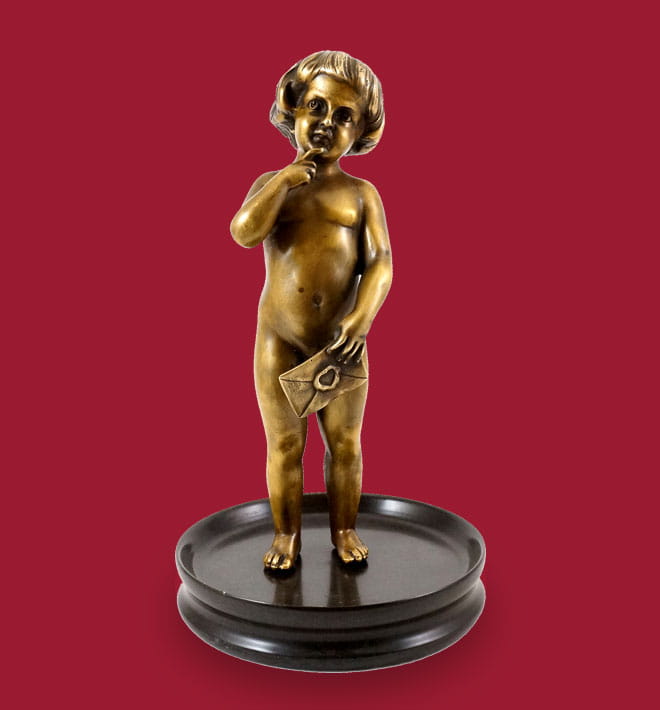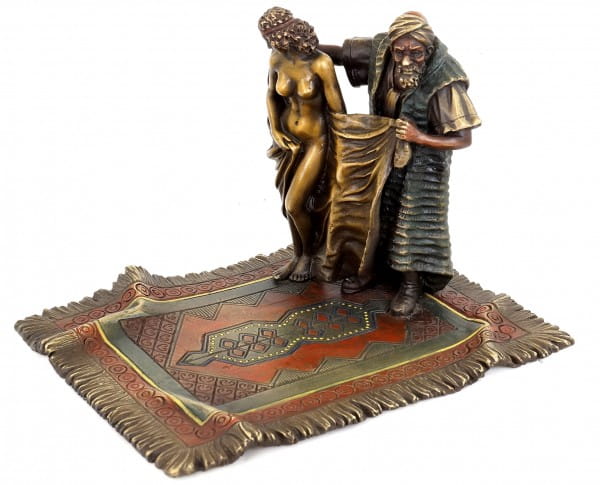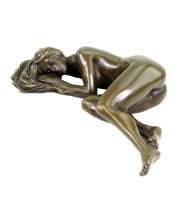€399.00 *
Prices incl. VAT, free shipping worldwide
Ready to ship today,
Delivery time appr. 3-6 workdays










Vienna Bronze – Carpet Trader with Female Slave - Franz Xaver Bergmann - Stamped This... more
Product description
"Vienna Bronze - Carpet Trader with Female Slave - Bergmann"
| Weight | 2,3 kg |
Vienna Bronze – Carpet Trader with Female Slave - Franz Xaver Bergmann - Stamped
This captivating bronze composition titled Carpet Trader with Female Slave stands as one of the most provocative and intricately detailed examples within the world of Vienna Bronze Miniatures. The scene depicts a merchant, cloaked in layered fabrics, holding back a richly textured carpet to reveal a Bedouin Girl — a vulnerable, nude figure whose body radiates a delicate balance between modesty and sensuality. The contrast between the man’s assertive posture and the woman’s shy, inward stance creates an atmosphere of psychological intensity and visual storytelling. Every fold of fabric, every shadow of the bronze surface, speaks of the artist’s mastery in translating emotion into metal. Through its careful modeling and nuanced patina, this Sexy Statue captures both the allure and unease of human interaction framed by cultural and moral boundaries.
The fascination of the exotic
Franz Xaver Bergmann’s Carpet Trader with Female Slave draws directly from the late 19th-century fascination with Orientalism, where distant lands and ancient traditions were reimagined through the lens of European fantasy. Deeply inspired by Persian Art, Bedouin Art, and Egyptian Art, Bergmann used these exotic motifs not merely for spectacle but to explore the emotional dynamics between power and vulnerability. The merchant’s heavy robes and the ornamented rug evoke the craftsmanship of Middle Eastern textile culture, while the figure of the Bedouin Girl embodies the eternal theme of beauty revealed and restrained. This interplay of luxury, sensuality, and restraint defines Bergmann’s genius, making each of his works both a narrative and a moral reflection.
Technical mastery and artistic subtlety
The Carpet Trader with Female Slave exemplifies the exceptional skill and precision that distinguish Vienna Bronze Miniatures. Each surface is treated with meticulous care — the fine weave of the carpet, the soft sheen of the woman’s skin, and the expressive features of the trader all demonstrate the high level of craftsmanship achieved in Bergmann’s Viennese foundry. The bronze is cast using the lost-wax process and hand-finished with delicate patinas to achieve the illusion of fabric, flesh, and depth. The colors, ranging from golden and ochre tones to deep green and brown, enhance the scene’s emotional warmth while preserving its narrative clarity. This attention to material and form transforms the sculpture into a dialogue between realism and imagination, placing Bergmann among the foremost interpreters of Persian Art and Bedouin Art in miniature form.
Franz Xaver Bergmann – the sculptor of imagination
Born on July 27, 1861, in Vienna, Franz Xaver Bergmann was the son of a skilled bronze caster who ran a small workshop in the Austrian capital. Surrounded by the world of metal casting from an early age, Bergmann developed a profound respect for craftsmanship and the expressive potential of bronze. After studying at the Academy of Fine Arts in Vienna, he expanded his father’s foundry into one of the most distinguished producers of Vienna Bronze Miniatures, combining precision engineering with creative storytelling. His sculptures often drew inspiration from Egyptian Art, Persian Art, and the desert worlds of Bedouin Women and Bedouin Art, blending cultural fascination with technical perfection. Bergmann died in Vienna on January 1, 1936, leaving behind a vast legacy that continues to shape the appreciation of fine bronzes across generations.
The emotional and symbolic dimension
This Sexy Statue is not merely a scene of sensual display but a meditation on human fragility, curiosity, and the passage between innocence and experience. The trader’s face, lined with age and wisdom, contrasts with the youth and purity of the Bedouin Girl, suggesting a dialogue between worldly knowledge and untouched beauty. The richly painted carpet beneath them is more than a setting — it acts as a symbolic boundary, representing both the stage of presentation and the threshold of vulnerability. Through these details, Bergmann captures the ambivalence of possession and admiration, of commerce and emotion, embodied in the delicate gestures of the figures. Such complexity is what makes his Vienna Bronze Miniatures both visually stunning and intellectually profound.
Legacy and collections worldwide
Today, Carpet Trader with Female Slave and related works by Franz Xaver Bergmann can be admired in renowned collections such as the Museum of Applied Arts (MAK) in Vienna, the Musée d’Orsay in Paris, and several important private collections in London, Munich, and New York. These works remain celebrated for their technical brilliance and their unique ability to merge cultural storytelling with sculptural finesse. In depicting scenes drawn from Egyptian Art, Bedouin Art, Bedouin Women, and Persian Art, Bergmann gave shape to the European imagination of the East— passionate, mysterious, and timeless. His bronzes endure not only as decorative masterpieces but as lasting symbols of artistic craftsmanship and human expression.
This captivating bronze composition titled Carpet Trader with Female Slave stands as one of the most provocative and intricately detailed examples within the world of Vienna Bronze Miniatures. The scene depicts a merchant, cloaked in layered fabrics, holding back a richly textured carpet to reveal a Bedouin Girl — a vulnerable, nude figure whose body radiates a delicate balance between modesty and sensuality. The contrast between the man’s assertive posture and the woman’s shy, inward stance creates an atmosphere of psychological intensity and visual storytelling. Every fold of fabric, every shadow of the bronze surface, speaks of the artist’s mastery in translating emotion into metal. Through its careful modeling and nuanced patina, this Sexy Statue captures both the allure and unease of human interaction framed by cultural and moral boundaries.
The fascination of the exotic
Franz Xaver Bergmann’s Carpet Trader with Female Slave draws directly from the late 19th-century fascination with Orientalism, where distant lands and ancient traditions were reimagined through the lens of European fantasy. Deeply inspired by Persian Art, Bedouin Art, and Egyptian Art, Bergmann used these exotic motifs not merely for spectacle but to explore the emotional dynamics between power and vulnerability. The merchant’s heavy robes and the ornamented rug evoke the craftsmanship of Middle Eastern textile culture, while the figure of the Bedouin Girl embodies the eternal theme of beauty revealed and restrained. This interplay of luxury, sensuality, and restraint defines Bergmann’s genius, making each of his works both a narrative and a moral reflection.
Technical mastery and artistic subtlety
The Carpet Trader with Female Slave exemplifies the exceptional skill and precision that distinguish Vienna Bronze Miniatures. Each surface is treated with meticulous care — the fine weave of the carpet, the soft sheen of the woman’s skin, and the expressive features of the trader all demonstrate the high level of craftsmanship achieved in Bergmann’s Viennese foundry. The bronze is cast using the lost-wax process and hand-finished with delicate patinas to achieve the illusion of fabric, flesh, and depth. The colors, ranging from golden and ochre tones to deep green and brown, enhance the scene’s emotional warmth while preserving its narrative clarity. This attention to material and form transforms the sculpture into a dialogue between realism and imagination, placing Bergmann among the foremost interpreters of Persian Art and Bedouin Art in miniature form.
Franz Xaver Bergmann – the sculptor of imagination
Born on July 27, 1861, in Vienna, Franz Xaver Bergmann was the son of a skilled bronze caster who ran a small workshop in the Austrian capital. Surrounded by the world of metal casting from an early age, Bergmann developed a profound respect for craftsmanship and the expressive potential of bronze. After studying at the Academy of Fine Arts in Vienna, he expanded his father’s foundry into one of the most distinguished producers of Vienna Bronze Miniatures, combining precision engineering with creative storytelling. His sculptures often drew inspiration from Egyptian Art, Persian Art, and the desert worlds of Bedouin Women and Bedouin Art, blending cultural fascination with technical perfection. Bergmann died in Vienna on January 1, 1936, leaving behind a vast legacy that continues to shape the appreciation of fine bronzes across generations.
The emotional and symbolic dimension
This Sexy Statue is not merely a scene of sensual display but a meditation on human fragility, curiosity, and the passage between innocence and experience. The trader’s face, lined with age and wisdom, contrasts with the youth and purity of the Bedouin Girl, suggesting a dialogue between worldly knowledge and untouched beauty. The richly painted carpet beneath them is more than a setting — it acts as a symbolic boundary, representing both the stage of presentation and the threshold of vulnerability. Through these details, Bergmann captures the ambivalence of possession and admiration, of commerce and emotion, embodied in the delicate gestures of the figures. Such complexity is what makes his Vienna Bronze Miniatures both visually stunning and intellectually profound.
Legacy and collections worldwide
Today, Carpet Trader with Female Slave and related works by Franz Xaver Bergmann can be admired in renowned collections such as the Museum of Applied Arts (MAK) in Vienna, the Musée d’Orsay in Paris, and several important private collections in London, Munich, and New York. These works remain celebrated for their technical brilliance and their unique ability to merge cultural storytelling with sculptural finesse. In depicting scenes drawn from Egyptian Art, Bedouin Art, Bedouin Women, and Persian Art, Bergmann gave shape to the European imagination of the East— passionate, mysterious, and timeless. His bronzes endure not only as decorative masterpieces but as lasting symbols of artistic craftsmanship and human expression.
Height: 14 cm
Width: 15cm
Depth: 19,5 cm
Weight: 2.3Kg
Width: 15cm
Depth: 19,5 cm
Weight: 2.3Kg
Related links to "Vienna Bronze - Carpet Trader with Female Slave - Bergmann"
Read, write and discuss reviews... more
Customer evaluation for "Vienna Bronze - Carpet Trader with Female Slave - Bergmann"
Write an evaluation
Evaluations will be activated after verification.
Our advantages
free shipping
Worldwide free shipping
14 days money back
You can cancel your order
within 14 days
secure payment services
Paypal, Master Card, Visa, American Express and more




























































